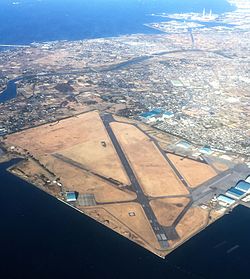Kisarazu Air Field
Kisarazu Air Field (木更津飛行場, Kisarazu Hikōjō) (ICAO: RJTK) is a Japanese military air field of the Japan Ground Self-Defense Force.[2] It is also known as JGSDF Camp Kisarazu (木更津駐屯地, Kisarazu Chūtonchi).
| Kisarazu Air Field 木更津飛行場 Kisarazu Hikōjō | |||
|---|---|---|---|

| |||
| IATA: none – ICAO: RJTK | |||
| Summary | |||
| Airport type | Military | ||
| Operator | |||
| Location | Kisarazu, Japan | ||
| Elevation AMSL | 10 ft / 3 m | ||
| Coordinates | 35°23′42″N 139°54′47″E / 35.39500°N 139.91306°ECoordinates: 35°23′42″N 139°54′47″E / 35.39500°N 139.91306°E | ||
| Website | |||
| Map | |||
| Location in Japan | |||
| Runways | |||
| Direction | Length | Surface | |
| m | ft | ||
| 02/20 | 1,830 | 6,004 | Asphalt concrete |
| Source: Japanese AIP at AIS Japan[1] | |||
The air field is north northwest of Kisarazu, Chiba Prefecture. Private charter jets also use the airport[3]
Operations
JGSDF Kisarazu is home to the JGSDF 1st Helicopter Brigade. These forces are part of the Central Readiness Force.[4]
The immediate JGSDF response to the 2011 Tōhoku earthquake and tsunami included helicopters from the 1st Helicopter Unit.[5]
After the Fukushima nuclear disaster, helicopters from Kisarazu sprayed seawater from above the plant onto the damaged reactor.[6]
History
Kisarazu Air Field was originally established in 1936 as a base for the Imperial Japanese Navy Air Service in the Yokosuka Naval District.[7]
After the end of World War II, the base was used by the United States Air Force (USAF) as "Kisarazu Air Base".[8]
In 1955, the runway was expanded to multiple jet bomber operational length.[9]
In 1956, control of the base was officially transferred to the Japan Air Self-Defense Force (JASDF). Some USAF units remained.
By the 1960s, the US only used Kisarazu to repair United States Navy jets stationed on aircraft carriers in the Pacific. The US military units at this air field were withdrawn.[10]
In 1968, the JASDF relocated to Iruma Air Base, and Kisarazu was transferred to JGSDF.
Related pages
References
- ↑ AIS Japan Archived 2011-07-22 at the Wayback Machine
- ↑ Facilities, Japan Ground Self Defense Force; retrieved 2012-1-23.
- ↑ Pilot information for Kisarazu Airport Archived 2016-03-04 at the Wayback Machine; retrieved 2012-1-23.
- ↑ Organizational Diagram of the Self-Defense Forces; "What is the CRF (Central Readiness Force)?; retrieved 2012-1-23.
- ↑ Mizokami, Kyle. "Tohoku Earthquake: The SDF and the First 24 Hours,"[dead link] Japan Security Watch. May 30, 2011, citing Hidemichi Katsumata, "Disaster Relief Operations of the JSDF for the Great East Japan Earthquake," Sekai no Kansen (Ships of the World). June 2011; compare "Japan had to show U.S. it took nuclear accident seriously," Asahi Shimbun. May 21, 2011; retrieved 2012-1-24.
- ↑ Katsumata, Hidemichi. "SDF Constantly on Call for Worst at N-plant," Archived 2011-11-02 at the Wayback Machine Daily Yomiuri. May 27, 2011; retrieved 2012-1-24.
- ↑ Pettie, Mark R. (2007). Sunburst: The Rise of Japanese Naval Air Power, 1909-1941, p. 256.
- ↑ Mikesh, Robert C. (1993). Broken Wings of the Samurai: the Destruction of the Japanese Airforce, p. 97.
- ↑ Hailey, Foster. "Bases U. S. TO Cut Bases, Tokyo Announces," New York Times. July 21, 1955; retrieved 2012-1-22.
- ↑ Shabecoff, Philip. "Bases U.S. Will Yield to Japan Termed Marginal," New York Times. December 27, 1968; retreieved 2012-1-24.